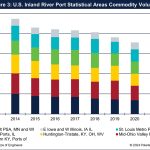Horizons: Connecting The Hinterlands & The World Through America’s River Ports

In previous Horizons columns, I wrote that cargo is king, and on the inland rivers, barge makes cargo royalty. If barge makes cargo royalty, then inland ports and terminals are the cupbearers.
A cupbearer serves royalty to ensure they will survive what they eat or drink. In many respects, ports and terminals assure shippers their cargo will move from land to water or water to land, from one mode to another.
Ports & Terminals On The Mississippi River System
Across the United States there are more than 350 ports. A popular saying among the port community is if you see one port, you have seen one port, and not all ports are created equal.
Ports have varying organizational structures. Some are operating ports, others landlord ports. They handle different commodities and serve any number of markets, commodities and industries. Thus, investment requirements are different from one port to the next.
Along the banks of the Mississippi River and Tributaries system, which includes the Ohio, Tennessee, Illinois, Mississippi, Missouri and Arkansas rivers, there are dozens of ports and hundreds of terminals. Some are located near population centers such as Memphis, Tenn., St. Louis, Chicago, Minneapolis and St. Paul, Minn., Louisville, Ky., Cincinnati, Ohio, Little Rock, Ark., and other locations. Other ports and terminals are located near sources of natural resources such as coal, minerals, sand and gravel, or grain and soybeans. Still others are near manufacturing or refining facilities.
There are also seven Port Statistical Areas (PSA) along the Mississippi River system. PSAs are amalgamations of port areas across geographical boundaries. The purpose of a PSA is to leverage the regional efforts and capabilities of ports and terminals while having a unified voice with public officials, regulators and shippers. The Corps of Engineers defines a PSA as “a region with formally justified shared economic interests and collective reliance on infrastructure related to waterborne movements of commodities that is formally recognized by legislative enactments of state, county or city governments.”
Based on information from the Corps in the “U.S. Coastal and Inland Navigation System, 2022 Transportation Facts & Information” card, of the 5,757 docks used for domestic waterway cargo, more than a third are located along the Mississippi River system.
Ports and PSAs are shown on the map in Figure 1. One note is that the location of the ports and PSAs reflect political boundaries. The boundaries do not reflect the relative cargo volume moved through each location.
River Ports Speak Volumes
During 2022, the top inland river ports in the United States were located along the Mississippi River System, each handling about 5 million short tons or more. The top 15 ports are shown in Figure 2.
The river ports of the Southern Indiana District, bordering the Ohio River as reported by the Corps, handled the highest volume at 27.7 million tons during 2022. The Corps aligns the Indiana ports in two districts, the northern ports on the Great Lakes and the southern river ports (Evansville, Mount Vernon and Jeffersonville) on the Ohio River.
The Port of Pittsburgh recorded the second highest volume in 2022 with 17.4 million tons, followed by the Mid-American Port of Iowa, Illinois and Missouri with 13.2 million and the New Bourbon Port Authority in Missouri with 10.3 million tons. The remaining top ports handled fewer than 10 million tons each during 2022.
While the reconfigured ports of the Southern Indiana District had the highest volume in 2022, it peaked at 40.1 million tons in 2014. Over the past decade its volumes have been down 21 percent due to lost coal tonnage despite corn growth slightly offsetting the coal losses. The Port of Pittsburgh lost the most volume over the past decade, down 15.3 million tons. On average, the top 15 ports lost an average of 1.7 million tons each over the past 10 years.
While Paducah-McCracken Riverport in Kentucky handled the 10th highest volume at 7.2 million tons in 2022, it had the fastest growth, increasing 179 percent over the past decade. The growth at Paducah-McCracken has been handling coal (even though most ports lost significant volumes), sand and gravel, gasoline and petroleum coke.
The commodity growth at the top 15 ports over the past decade has been led by corn that increased 7.7 million tons, sand and gravel up 6.2 million and soybeans up 3.8 million.
The combined cargo volume handled by the PSAs held steady above 200 million tons through 2018 and has since declined to about 174 million in 2022. Since 2013, the volume of cargo handled through the PSAs has fallen by 42.2 million tons or 20 percent.
Despite farm and food products in PSAs increasing 19.7 million tons in the past 10 years, coal, down a whopping 62.5 million tons, has more than offset those gains. The volume of cargo handled through the Port Statistical Areas is shown in Figure 3.
Keeping Cargo Flowing
The inland river ports of the Mississippi River and its tributaries are vital to the U.S. economy, despite handling less cargo over the past decade. They facilitate the efficient movement of goods, support a wide range of industries and contribute to the nation’s economic growth. While coal has been the laggard, other commodities and products are gaining in volume.
The continued investment in port infrastructure, supported by a combination of federal, state, local and private funding, is essential to maintaining the competitiveness of the U.S. inland waterway system.
As the “cupbearers” to the inland navigation system, now is a good time to be a Nehemiah, who was a cupbearer to King Artaxerxes. From the Old Testament book in his name, Nehemiah was called to inspect the walls of Jerusalem and prepare a plan to rebuild the walls. The inland ports need to be proactive and inspect their ports and see how they can rebuild the volumes they handle on the inland system.
In 2021, the Kentucky Transportation Cabinet did just that and is now putting its plan into practice to bolster its ports and support the industries moving cargo on the inland river system.
It is crucial to recognize the importance of these river ports and ensure necessary resources are deployed to continue driving economic growth and supporting the livelihoods of millions of Americans and the economy of the United States.






